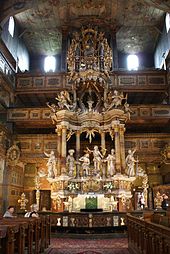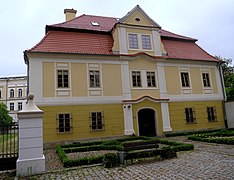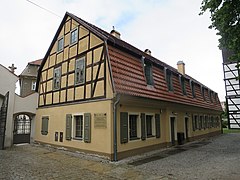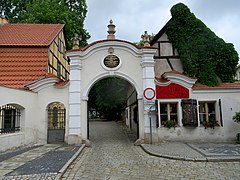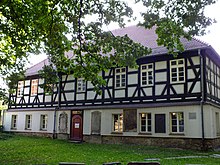Church of Peace (Świdnica)
| Peace Church of the Holy Trinity in Schweidnitz ( Kościół Pokoju pw.Świętej Trójcy w Świdnicy ) |
|
|---|---|
|
The Friedenskirche (from the south) |
|
| Construction year: | 1656-1657 |
| Inauguration: | June 24th ( St. John's Day ) 1657 |
| Architect : | Albrecht von Saebisch , Breslau |
| Style elements : | Baroque , half-timbered church |
| Client: | Evangelical parish in Schweidnitz |
| Space: | 7500 people |
| Location: | 50 ° 50 '46.1 " N , 16 ° 29' 29.9" E |
| Address: | Plac Pokoju Świdnica Lower Silesia , Poland |
| Purpose: | Evangelical Lutheran Parish Church |
| Parish: | Plac Pokoju 6, 58-100 Świdnica |
| Regional Church : | Evangelical-Augsburg Church in Poland , Diocese of Wroclaw |
| Website: | kosciolpokoju.pl |
The Evangelical Peace Church of the Holy Trinity ( Kościół Pokoju pw. Świętej Trójcy ) in Świdnica ( German Schweidnitz ) is one of the most important sights in Silesia . It is located since 2001 in cooperation with the Church of Peace in Jawor ( German Jauer ) entitled Peace Churches in Jawor and Swidnica on the World Heritage list of UNESCO and is considered the largest half-timbered church in Europe .
history

The construction of the Schweidnitzer church is based on a concession made by Emperor Ferdinand III. back that he had to make the Silesian Protestants in the Peace of Westphalia to build a peace church in the three hereditary principalities of Glogau , Jauer and Schweidnitz. The implementing regulations were established by the State Chancellery in Prague. This limited the building material to wood, sand, clay and straw, banned towers and schools and stipulated a site outside the city walls as building land. In addition, the church had to be completed within a year.
The church was built according to a design by the Breslau architect Albrecht von Saebisch (1610–1688). In 1656, the evangelical congregation was given a site measuring 200 by 200 steps, on which the foundation stone for the half-timbered building was laid in August 1656 . Less than a year later, thanks to the great efforts of the Protestants, the church was finished and on June 24, 1657 the first service was held in it. The church, built as a half-timbered construction, has an area of approx. 1090 m² and offers space for approx. 7500 people, including approx. 3000 on seats.
The Altranstadt Convention of 1707 allowed the addition of towers and bells. Then one was in 1708 next to the church bell tower also in timber-framed construction.
After the political upheaval in Poland towards the end of the 20th century, the restoration of the church could begin, but the interior renovation had to be canceled in 2002 for financial reasons.
architecture
The Friedenskirche is of the type of a basilica with a Greek cross as a floor plan. The sacristy , also known as the baptismal hall, was added to this basic shape in the east . In the following years the “death hall” was built in the west, the “field hall” in the north and the representative “wedding hall” in the south. Aristocratic families built their own boxes around the building, with separate entrances from the outside.
Furnishing
The magnificent furnishings are in the Baroque style.
Christoph Kalicki and Christian Süßenbach were responsible for the paintings from 1696 on the ceiling of the main nave, the side aisles and the transept . The galleries are also richly painted and decorated.
The Hochberg Lodge was built in 1698 out of gratitude for the von Hochberg and von Reuss families who supported the Protestants.
Gotfried August Hoffman created the pulpit in 1729 and the altar in 1752 for the 100th anniversary of the imperial building permit.
The baptismal font in the " baptismal hall" from 1661 comes from the workshop of Pankratius Werner from Hirschberg .
Organ and music
The large organ from 1666 to 1669 is the work of Christoph Klose from Brieg . The church also has a small organ.
Among the organist of the church belonged since December 1729 Christoph Gottlob Wecker (1700-1774), a student of Johann Sebastian Bach . For this reason, a Bach Festival ( Międzynarodowy Festiwal Bachowski ) has been held every summer since 2000 .
Building ensemble
The Friedenskirche in Schweidnitz stands on a walled area, which today is called "Friedensplatz" (Plac Pokoju) and, with its cemetery and the associated buildings of the parish, is a listed ensemble . The individual parts are gradually being renovated and each put to a suitable use.
The following parts together with the Friedenskirche form the ensemble:
- Former rectory , today "Lower Silesian Evangelical Institute",
- Bell tower, built in 1708, has bells and a carillon, has been renovated and is also used as an art gallery,
- Former Protestant high school, built in 1708, today "Lutherheim", a guesthouse called "Barocker Winkel",
- Former bell ringer house , renovated in 2012, serves as an exhibition building and center for UNESCO advertising,
- Former guard house, next to the entrance gate, is a café with regional goods.
- Former cemetery, used until the end of the 19th century, in need of renovation, including the enclosure and the gates.
The Friedensplatz is surrounded by a one kilometer long wall, the main gate of which is next to the guard house. The gate bears a cartouche with the construction date 1730 and an inscription of homage to Emperor Charles VI. According to many experts, the Friedensplatz is one of the most beautiful ensembles of old Lutheran architecture in Silesia.
Evangelical school at the church
According to the Altranstadt Convention of August 22, 1707, the construction of Protestant schools in the peace churches was permitted. The construction of the Schweidnitz Latin School began on March 6, 1708, and the building was finished by the end of the year. During the Seven Years War , in 1761, the building suffered severe damage. In 1813 the school became a high school and in 1822 a municipal institution. In 1854 it was moved to a new building.
Well-known students include a. Johann Christian Günther and Carl Gotthard Langhans , the builders of the Brandenburg Gate .
literature
- newest works first -
- Stephan Aderhold: Chronological music history of the evangelical community in the Friedenskirche zu Schweidnitz taking into account the development of its church archive - Historia muzyki Kościoła Pokoju w Świdnicy z uwzlednieniem rozwoju archiwum kościelnego . Świdnica 2015, OCLC 1030296797 (printed as manuscript).
- Believe like a heart made of ore - treasures of the Friedenskirche in Schwednitz . Edited by the Agencja Wydawnicza ARGI sc, Świdnica 2012, ISBN 978-83-928160-3-4 .
- Stephan Aderhold: Catalog of the music and archive material of the Friedenskirche zu Schweidnitz . Electronic publication, Świdnica 2012.
- Reiner Sörries: By the grace of the emperor - Protestant church buildings in the Habsburg Empire. Böhlau Verlag, Cologne / Weimar / Vienna 2008, ISBN 978-3-412-20154-8 .
- Agnieszka Seidel-Grzesińska: The “visible word of God” on the ceiling of the Evangelical Peace Church in Schweidnitz. In: Cultural history of Silesia in the early modern times (= early modern times. Volume 111). Edited by Klaus Garber . Volume 2 (pp. 539-1131). Niemeyer, Tübingen 2005, ISBN 3-484-36611-7 , pp. 911-924.
- Hans Caspary: The Silesian peace churches in Schweidnitz and Jauer. A German-Polish cultural heritage (= Potsdam Library Eastern Europe - art ). Edited by the German Cultural Forum for Eastern Europe . With an introduction by Andrzej Tomaszewski . Ed .: Claudia Tutsch, Tanja Krombach. German Cultural Forum for Eastern Europe, Potsdam 2005, ISBN 3-936168-24-5 ; 2., revised. and exp. Potsdam 2009 edition, ISBN 978-3-936168-50-1 .
- Jörg Deventer: Counter Reformation in Silesia. The Habsburg re-Catholicization policy in Glogau and Schweidnitz 1526–1707 (= New Research on Silesian History, Volume 8). Böhlau, Cologne / Weimar / Vienna 2003, ISBN 3-412-06702-4 .
- Izabella Gawin, Dieter Schulze, Reinhold Vetter : Silesia - German and Polish cultural traditions in a European border region (= DuMont art travel guide ). DuMont Verlag, Cologne 1999, ISBN 3-7701-4418-X , pp. 139-141.
- The Friedenskirche zu Schweidnitz (= sheets on cultural work. Volume 72) Edited by the Evangelical Church Community in Schweidnitz / Świdnica and the Federal Association of German Youth in Europe . Schweidnitz / Bonn 1993, DNB 941409880 .
- Hellmuth Bunzel: The Friedenskirche zu Schweidnitz. History of a peace church from its creation to its sinking into museum existence. Erg. and rework. Verl. Our way, Ulm / Donau 1958, DNB 450704882 .
- Ludwig Worthmann: Guide through the Friedenskirche zu Schweidnitz. L. Heege, Schweidnitz and Breslau 1929, DNB 578434326 ; Special dr. [the edition] Schweidnitz, Breslau, Heege, [1902]: Schlesierverl. Heege, Reutlingen [1994?], DNB 942022998 .
- Adolf Wasner: The Schweidnitzer Friedenskirche to the Holy Trinity. [2. Ed.] L. Heege, Schweidnitz 1924, DNB 578232340 (1903 1 ).
Web links
- The Peace Church in Schweidnitz. In: friedenskirche-schweidnitz.de. Peace Church in Schweidnitz - Parafia Ewangelicko-Augsburska pw. Św. Trójcy, archived from the original on June 17, 2017 (last working memento at archive.org/web ).
- Website of the Evangelical Church Community in Schweidnitz. In: luteranie.wroc.pl (Polish, German, English)
- Spherical panorama. (No longer available online.) In: polska.travel. Formerly in the original (mementos at timetravel.mementoweb.org not informative). ( Page no longer available , search in web archives )
- Schweidnitz Church of Peace. In: kosciolpokoju.pl (Polish and German)
- Schweidnitz Church of Peace. In: wiki-de.genealogy.net
- Forum Polskich Miast i Miejsc UNESCO (Polish)
- Międzynarodowy Festiwal Bachowski Świdnica Bach Festival (Polish)
Individual evidence
- ↑ Thomas Greif: Why the Friedenskirche Schweidnitz is so special. (No longer available online.) In: Sonntagsblatt Bayern . February 15, 2015, archived from the original on September 2, 2018 ; accessed on September 6, 2019 .
- ↑ Thomas Greif: Wooden Wonder of the World - The Peace Church of Schweidnitz is denominational and unique in art history ( Memento from May 24, 2018 in the Internet Archive ). In: Sunday newspaper Bavaria . Edition 07/2015, February 15, 2015, accessed on May 6, 2015 ("Few Protestant churches have such symbolic power as the Peace Church of Swidnica (Schweidnitz) in Lower Silesia, Poland. Peace and hope, mourning and reconciliation, despair and pride - everything comes together here. ").
- ↑ Church leaders of the Lutheran parish: The Peace Church in Schweidnitz. o. O. and o. J.

